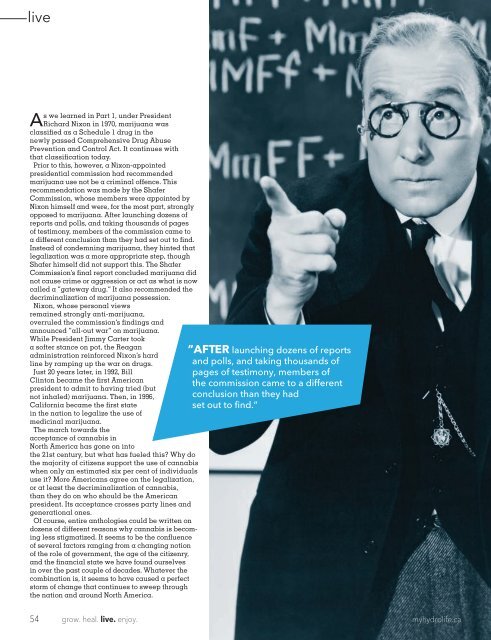Hydrolife Magazine April/May 2017 (Canada Edition)
To know where you’re going, you have to know where you’ve been. The adage rings true for the modern cannabis industry, which is why this issue of Hydrolife takes a look back at the roots of marijuana and how the plant has traveled through history in North America (History of Cannabis Part II).
To know where you’re going, you have to know where you’ve been. The adage rings true for the modern cannabis industry, which is why this issue of Hydrolife takes a look back at the roots of marijuana and how the plant has traveled through history in North America (History of Cannabis Part II).
Create successful ePaper yourself
Turn your PDF publications into a flip-book with our unique Google optimized e-Paper software.
live<br />
As we learned in Part 1, under President<br />
Richard Nixon in 1970, marijuana was<br />
classified as a Schedule 1 drug in the<br />
newly passed Comprehensive Drug Abuse<br />
Prevention and Control Act. It continues with<br />
that classification today.<br />
Prior to this, however, a Nixon-appointed<br />
presidential commission had recommended<br />
marijuana use not be a criminal offence. This<br />
recommendation was made by the Shafer<br />
Commission, whose members were appointed by<br />
Nixon himself and were, for the most part, strongly<br />
opposed to marijuana. After launching dozens of<br />
reports and polls, and taking thousands of pages<br />
of testimony, members of the commission came to<br />
a different conclusion than they had set out to find.<br />
Instead of condemning marijuana, they hinted that<br />
legalization was a more appropriate step, though<br />
Shafer himself did not support this. The Shafer<br />
Commission’s final report concluded marijuana did<br />
not cause crime or aggression or act as what is now<br />
called a “gateway drug.” It also recommended the<br />
decriminalization of marijuana possession.<br />
Nixon, whose personal views<br />
remained strongly anti-marijuana,<br />
overruled the commission’s findings and<br />
announced “all-out war” on marijuana.<br />
While President Jimmy Carter took<br />
a softer stance on pot, the Reagan<br />
administration reinforced Nixon’s hard<br />
line by ramping up the war on drugs.<br />
Just 20 years later, in 1992, Bill<br />
Clinton became the first American<br />
president to admit to having tried (but<br />
not inhaled) marijuana. Then, in 1996,<br />
California became the first state<br />
in the nation to legalize the use of<br />
medicinal marijuana.<br />
The march towards the<br />
acceptance of cannabis in<br />
North America has gone on into<br />
the 21st century, but what has fueled this? Why do<br />
the majority of citizens support the use of cannabis<br />
when only an estimated six per cent of individuals<br />
use it? More Americans agree on the legalization,<br />
or at least the decriminalization of cannabis,<br />
than they do on who should be the American<br />
president. Its acceptance crosses party lines and<br />
generational ones.<br />
Of course, entire anthologies could be written on<br />
dozens of different reasons why cannabis is becoming<br />
less stigmatized. It seems to be the confluence<br />
of several factors ranging from a changing notion<br />
of the role of government, the age of the citizenry,<br />
and the financial state we have found ourselves<br />
in over the past couple of decades. Whatever the<br />
combination is, it seems to have caused a perfect<br />
storm of change that continues to sweep through<br />
the nation and around North America.<br />
”AFTER launching dozens of reports<br />
and polls, and taking thousands of<br />
pages of testimony, members of<br />
the commission came to a different<br />
conclusion than they had<br />
set out to find.“<br />
54 grow. heal. live. enjoy.<br />
myhydrolife.ca




![Hydrolife Magazine December 2017/January 2018 [CANADIAN EDITION]](https://img.yumpu.com/59790088/1/190x247/hydrolife-magazine-december-2017-january-2018-canadian-edition.jpg?quality=85)
![Hydrolife Magazine December 2017/January 2018 [USA EDITION]](https://img.yumpu.com/59790042/1/190x247/hydrolife-magazine-december-2017-january-2018-usa-edition.jpg?quality=85)
![Hydrolife Magazine October/November 2017 [Canada Edition]](https://img.yumpu.com/59493562/1/190x247/hydrolife-magazine-october-november-2017-canada-edition.jpg?quality=85)
![Hydrolife Magazine October/November 2017 [USA Edition]](https://img.yumpu.com/59493548/1/190x247/hydrolife-magazine-october-november-2017-usa-edition.jpg?quality=85)
![Hydrolife Magazine August/September 2017 [USA Edition]](https://img.yumpu.com/59236656/1/190x247/hydrolife-magazine-august-september-2017-usa-edition.jpg?quality=85)








